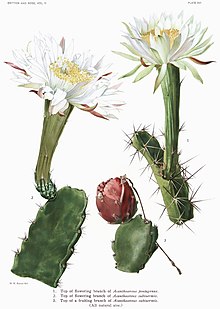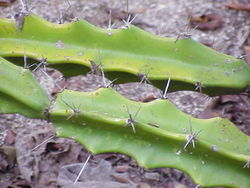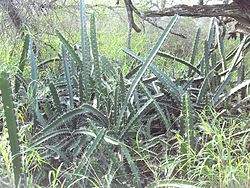Acanthocereus
| Acanthocereus | |
|---|---|

| |
| A. tetragonus flower (right), A. subinermis flower and fruit (left) | |
| Scientific classification | |
| Kingdom: | |
| (unranked): | |
| (unranked): | |
| (unranked): | |
| Order: | |
| Family: | |
| Subfamily: | |
| Tribe: | |
| Genus: | Acanthocereus |
| Type species | |
| Acanthocereus baxaniensis | |
| Species | |
|
Acanthocereus baxaniensis | |
Acanthocereus is a genus of cacti. Its species take the form of shrubs with arching or climbing stems up to several meters in height. The generic name is derived from the Greek word άκανθα (acantha), meaning spine,[2] and the Latin word cereus, meaning candle.[3]
The six species occur in the tropical Americas from the southern tip of Florida to Colombia, including islands of the Caribbean.
Stems have 3 to 5 ribs, typically thin, with stout spines. The pretty white funnel-shaped flowers are night-opening, 12–25 cm (4.7–9.8 in) long and 6–12 cm (2.4–4.7 in) in diameter.

Acanthocereus tetragonus, commonly known as Barbed-wire Cactus, Chaco, Nun-tsusuy, or Órgano, is the most widespread of the genus and the largest, reaching 2–7 m (6.6–23.0 ft) tall.
The name was first used by George Engelmann in 1863, although he did not describe its characters, leaving it to Alwin Berger in 1905 to define it as a subsection of Cereus. In 1909, Nathaniel Britton and Joseph Nelson Rose elevated Acanthocereus to a genus.[4]

Synonymy
The genera Dendrocereus Britton & Rose and Monvillea Britton & Rose have been brought into synonymy.
Species
| Image | Scientific name | Distribution |
|---|---|---|
 |
Acanthocereus baxaniensis (Karwinsky ex Pfeiff.) Borg | Cuba |
| Acanthocereus colombianus Britton & Rose | Colombia | |
| Acanthocereus horridus Britton & Rose | southeastern Mexico, Guatemala, El Salvador | |
| Acanthocereus occidentalis Britton & Rose | southern Sonora to Guerrero, Mexico | |
| Acanthocereus subinermis Britton & Rose | Oaxaca, Mexico | |
 |
Acanthocereus tetragonus (L.) Hummelinck – Barbed-wire Cactus | Lower Rio Grande Valley of Texas, Florida, the Caribbean, Mexico, Central America, northern South America[4] |
References
- ^ "Acanthocereus (Engelm. ex A. Berger) Britton & Rose". Germplasm Resources Information Network. United States Department of Agriculture. 2007-12-04. Archived from the original on 2011-06-06. Retrieved 2009-12-04.
- ^ Eggli, U.; Newton, L.E. (2004). Etymological Dictionary of Succulent Plant Names. Springer Berlin Heidelberg. p. 1. ISBN 978-3-540-00489-9. Retrieved 20 September 2018.
- ^ Couplan, François; James Duke (1998). Encyclopedia of Edible Plants of North America. McGraw Hill Professional. p. 92. ISBN 978-0-87983-821-8.
- ^ a b Anderson, Edward F. (2001). The Cactus Family. Timber Press. pp. 106–108. ISBN 978-0-88192-498-5.
External links
![]() Media related to Acanthocereus at Wikimedia Commons
Media related to Acanthocereus at Wikimedia Commons
![]() Data related to Acanthocereus at Wikispecies
Data related to Acanthocereus at Wikispecies
